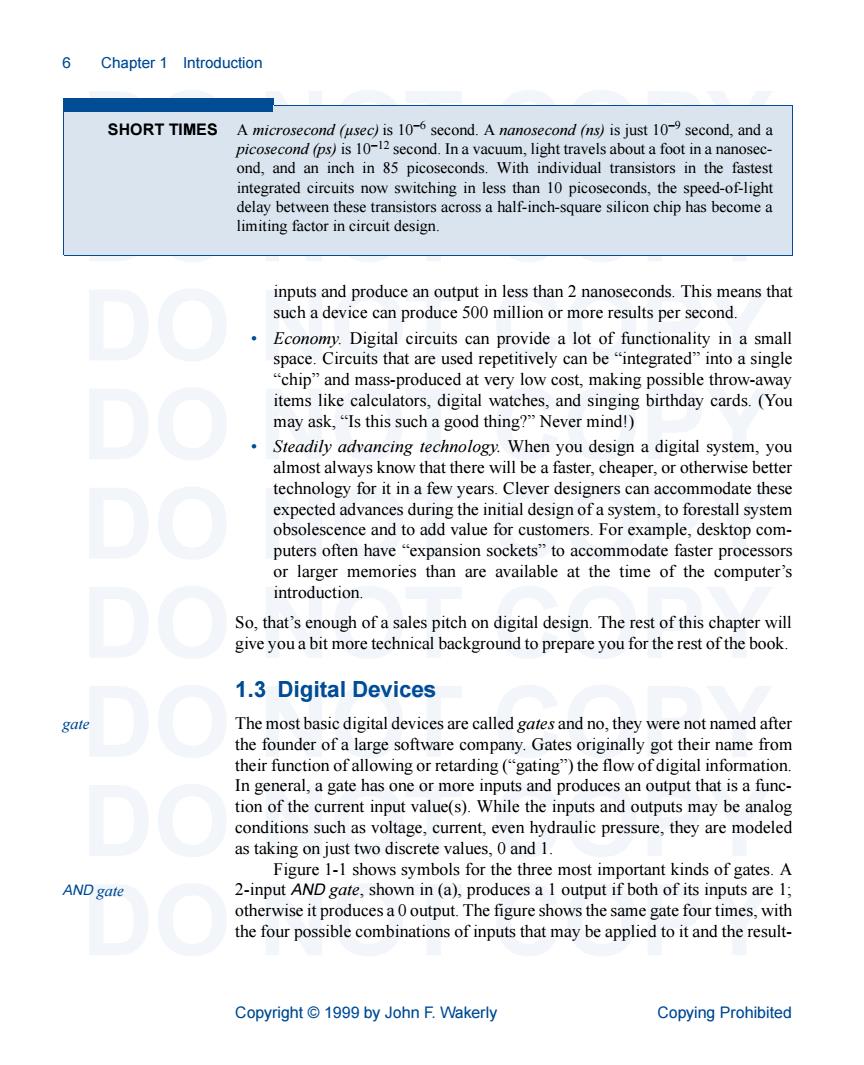正在加载图片...

6 Chapter 1 Introduction SHORT TIMES A microsecond (usec)is 10-6 second.A nanosecond (ns)is just 10-second.and a econd (ps)is 10-12 second.In a vacuum.light travels about a foot in a nanosec- integrated iruts now switching in less than 1,the speed-of-igh delay between these transistors across a half-inch-square silicon chip has become a limiting factor in circuit design. inputs and produce an output in less than 2 nanoseconds.This means that such a device can produce 500 million or more results per second. Economy.Digital circuits can provide a lot of functionality in a small space.Circuits that are used repetitively can be"integrated"into asingl "chip"and mass-produced at very low cost,making possible throw-away items like calculators,digital watches,and singing birthday cards.(You may ask,"Is this such a good thing?"Never mind!) Steadily advancing technology.When you design a digital system,you expected advances during the initial design of a system,to forestall system obsolescence and to add value for customers.For example,desktop com- puters often have"expansion sockets"to accommodate faster processors or larger memories than are available at the time of the computer's introduction. othat's enough ofa sales pitch on digital design.The rest of this chapter will give you a bit more technical background to prepare you for the rest of the book. 1.3 Digital Devices gate The most basic digital devices are called gates and no,they were not named after the founder of a large software company.Gates originally got their name from their function of allowing or retarding("gating")the flow of digital information In general,a gate has one or more i and produces an output that is a func tion of the current input value(s).While the inputs and outputs may be analog conditions such as voltage,current,even hydraulic pressure,they are modeled as taking on just two discrete values,0and 1. Figure 1-1 shows symbols for the three most important kinds of gates.A AND gate 2-input AND gate,shown in (a),produces a I output if both of its inputs are 1; otherwise it produces a0 output.The figure shows the same gate four times,with the four possible combinations of inputs that may be applied to it and the result- Copyright1999 by John F.Wakerly Copying Prohibited 6 Chapter 1 Introduction DO NOT COPY DO NOT COPY DO NOT COPY DO NOT COPY DO NOT COPY DO NOT COPY DO NOT COPY DO NOT COPY DO NOT COPY Copyright © 1999 by John F. Wakerly Copying Prohibited inputs and produce an output in less than 2 nanoseconds. This means that such a device can produce 500 million or more results per second. • Economy. Digital circuits can provide a lot of functionality in a small space. Circuits that are used repetitively can be “integrated” into a single “chip” and mass-produced at very low cost, making possible throw-away items like calculators, digital watches, and singing birthday cards. (You may ask, “Is this such a good thing?” Never mind!) • Steadily advancing technology. When you design a digital system, you almost always know that there will be a faster, cheaper, or otherwise better technology for it in a few years. Clever designers can accommodate these expected advances during the initial design of a system, to forestall system obsolescence and to add value for customers. For example, desktop computers often have “expansion sockets” to accommodate faster processors or larger memories than are available at the time of the computer’s introduction. So, that’s enough of a sales pitch on digital design. The rest of this chapter will give you a bit more technical background to prepare you for the rest of the book. 1.3 Digital Devices The most basic digital devices are called gates and no, they were not named after the founder of a large software company. Gates originally got their name from their function of allowing or retarding (“gating”) the flow of digital information. In general, a gate has one or more inputs and produces an output that is a function of the current input value(s). While the inputs and outputs may be analog conditions such as voltage, current, even hydraulic pressure, they are modeled as taking on just two discrete values, 0 and 1. Figure 1-1 shows symbols for the three most important kinds of gates. A 2-input AND gate, shown in (a), produces a 1 output if both of its inputs are 1; otherwise it produces a 0 output. The figure shows the same gate four times, with the four possible combinations of inputs that may be applied to it and the resultSHORT TIMES A microsecond (µsec) is 10−6 second. A nanosecond (ns) is just 10−9 second, and a picosecond (ps) is 10−12 second. In a vacuum, light travels about a foot in a nanosecond, and an inch in 85 picoseconds. With individual transistors in the fastest integrated circuits now switching in less than 10 picoseconds, the speed-of-light delay between these transistors across a half-inch-square silicon chip has become a limiting factor in circuit design. gate AND gate